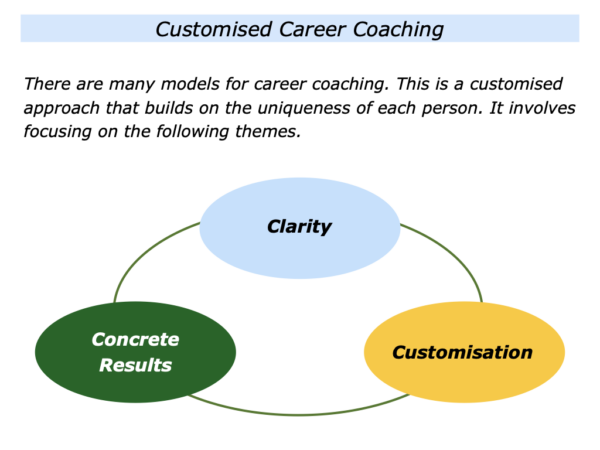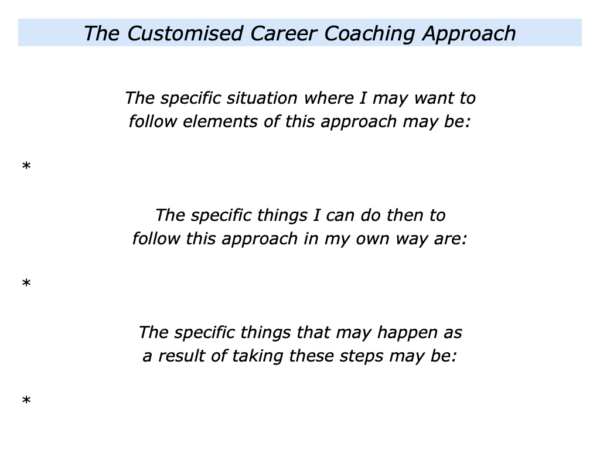
There are many models for helping people to shape their careers. This is an approach that focuses on the uniqueness of each person. It then involves working through the following themes.
Clarity – clarifying the person’s goals;
Customisation – providing customised support to help the person to achieve their goals;
Concrete Results – helping the person to achieve their goals.
Imagine that a person has asked for your help in shaping their career. If appropriate, you may start by focusing on the uniqueness of the person.
Some career coaches take this step by gathering information about the person before meeting them. Some do it during the session. Whichever route they take, they explore the following themes.
The Person’s Uniqueness
Who is the person I am going to meet? What have they done during their lives? What may have been their experiences? What may they have achieved? What may be their strengths?
What may be happening in their world at the moment? What may be the topics they want to explore? What may be the challenges they face? What may be their personal or professional goals?
Imagine that you have gathered information about the person. It can then be time to focus on the following theme.
Clarity
Different individuals may want to explore different topics when focusing on their career development. Here are some of the topics they may want to explore.
How to take the next step in my career … How to regain my zest for work … How to build on my strengths and manage any weaknesses … How to feel less stress in my work … How to build my own business.
How to turnaround a challenging team … How to manage my manager … How to develop a Plan B for my career … How to get the right blend between my work and wellbeing … How to work towards my career goals.
Imagine that the person has described the topic they want to explore. The next step will be establish clarify the real results they want to achieve.
Sometimes it can be useful to look at the wider picture. For example, to explore how pursuing a particular route will help them to work towards achieving their life goals.
Bearing in mind the theme the person wants to explore, you may want to ask the following questions. It is important to do this in an encouraging way, however, rather than putting them on the spot.
“Looking at the topic you want to explore, what are the real results you want to achieve? What would be your picture of success? What would be happening that would show you have achieved the goals? What would be the benefits of achieving these results?”
One person I worked with began by saying they wanted to get promoted to the C Suite. They said:
“I want to have more influence on shaping the company’s strategy. It would also look good on my CV. Plus the pay would be useful.”
They may be able but have more influence in the C Suite, but this was not guaranteed. The CEO shaped the company’s strategy and the leadership team meetings mostly consisted of progress reports.
Bearing this in mind, we focused on the real results the person wanted to achieve in their career. These were:
To build on their strengths and do pacesetting work that helped to shape a company’s future strategy;
To keep developing in their career and, if possible, get recognition for the work they did in shaping company strategies;
To get a good salary and maintain their life balance – particularly as they and their partner were raising a young family.
You will have your own approach to establishing clarity – the real results a person wants to achieve. Bearing these in mind, it can be time to move on to the next stage.
Customisation
Good career coaches provide customised support to help the person to shape their career. It is important to pass on knowledge in a way that is:
Personal – it relates to the person’s situation and helps them to achieve their goals;
Practical – it provides practical tools that the person can use to achieve their goals;
Profitable – it is, in the widest sense, profitable and will help them to achieve their goals.
Imagine that you are want to provide this kind of customised support. If appropriate, you may ask yourself the following questions.
What are the real results the person wants to achieve? What is their picture of success? What are the possible options they can pursue to achieve these aims? What are the pluses and minuses of each option?
What are the key strategies they can follow to give themselves the greatest chance of success? How can they build on their strengths when following these strategies?
Looking at my repertoire, what are the practical tools I can share that can help them to achieve their goals? How can I pass on this knowledge in a way they can use?
Let’s return to the person who wanted to reach the C Suite. We explored their various options together with the pluses and minuses of each option. The person also rated the attractiveness of each option.
Option A
They could stay in their present company, aim to get to the C Suite and work to shape the company’s strategy.
The pluses included: getting a good income, getting status and having a seat in the C suite.
The minuses included: putting in more hours, maybe not being able to influence the strategy.
Attractiveness: 7/10.
Option B
They could aim to get a role in the C Suite of another company and work to shape that company’s strategy.
The pluses included: a fresh start, getting a rise in income and having more authority.
The minuses included: finding such a role, proving themselves in the company, may not being able to influence the strategy, working long hours which could affect the family.
Attractiveness: 6/10.
Option C
They could aim to do pacesetting work in their present company, build successful prototypes and, in this way, maybe help to shape that company’s strategy.
The pluses included: knowing the company, knowing the areas where they could build such prototypes and getting some quick successes.
The minuses included: reorganising their schedule: a) to make sure their present responsibilities were covered; b) to lead the prototypes; still on the same pay; the successes they produced may or may not be adopted by the company.
Attractiveness: 7.5/10.
Bearing these options in mind, it was a close run thing between Options A and C. We began to look further ahead, however, in terms of the person’s career aims. Pursuing Option C could lead to the work being noticed by other companies and possibly job offers.
Taking this route would involve organising their work priorities properly, however, which was something we could work on. Looking ahead, we explored how to translate this strategy into an action plan.
You will have your own approach to customising the support that you offer to a person. This may involve drawing on your repertoire and providing practical tools that help them to reach their goals. This can then lead to the next stage.
Concrete Results
Imagine that the person you are helping has settled on the strategy they want to follow. If appropriate, you can encourage and enable them to pursue their chosen route.
Different people choose different paths. Whatever strategy they choose to pursue, it can be worth considering the following questions.
What is the route the person wants to follow? How can they translate this into a clear action plan? How can they get some quick successes? How can they manage any potential challenges? How can I do my best to help them to achieve their goals?
You will have your own way of helping the person to achieve their goals. If possible, however, it can be useful to focus on how they can get some quick successes.
Looking ahead, can you think of a situation where you may want to follow elements of the career coaching approach? How can you do this in your own way?
If you wish, try tackling the exercise on this theme. This invites you to complete the following sentences.



Leave a Reply